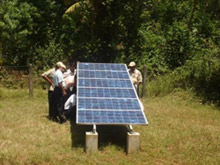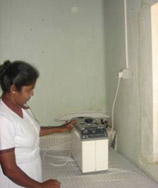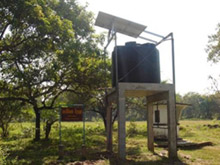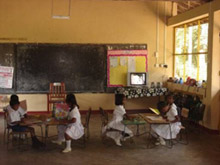Water
Supply
At the ancient monastery
at Nagadeepa, a solar power system, designed,
installed and maintained by Sunpower,
brings piped water. Water from the monastery's
overhead tower flows to the village school.
The Uva Region Photovoltaic
Power Rural Infrastructure Development
Project, launched in 1991 by the Ministry
of Housing & Construction, Government
of Sri Lanka, was, at that time, the largest
solar infrastructure project of its kind
in the world.
Sunpower, together with BP Solar, was
commissioned to install more than 100
systems for various uses. Water delivery,
lighting and maternity & public health
were 3 important focus areas. Solar powered
pumps were used to store water in overhead
tanks and deliver it to public taps. Not
only did this make day-to-day life easier,
it also encouraged cleanliness and personal
hygiene, which had a direct bearing on
the health of the population.
Public Health
Electricity from solar
power is ensuring a better, healthier
life for young and old alike by providing
essential facilities at maternity clinics,
hospitals, community centres and vocational
training centres.
Despite a well laid out network
of maternity clinics, dispensaries and
hospitals, Sri Lanka's rural public health
system used to suffer, in some areas,
from the lack of electricity.
Emergency deliveries had to be done by
candlelight. Post natal vaccines for infants
and snake bite venom had to be fetched
from long distances. Basic facilities
such as lighting, water heating and refrigeration
were not available.
Equally, because of the primitive living
conditions, it was difficult to attract
competent and dedicated staff to rural
hospitals.
Solar power installations helped to remove
these drawbacks and make the rural health
system far more effective. Vaccines needed
for immunisation programmes and anti-venom
for snakebites can now be refrigerated.
Childbirths are easier. Night lighting
has made the hospitals safer. Midwives,
equipped with solar lanterns, can make
house calls.
Sri Lanka's largest Off Grid Solar Project
1,614 systems in 7 districts, with more than 800kW in total, completed in less than 2 years to develop Rural Education and Health Infrastructure Facilities in Sri Lanka
The project, Solar Energy for the development of Rural Education and Health infrastructure facilities of Sri Lanka, targeted the improvement of infrastructure facilities of rural schools and health centres of seven districts in Sri Lanka. Ministry of Provincial Councils and Local Government implemented this project with financial assistance from Finland with Naps Systems Oy. of Finland as the project implementer.
Sunpower Systems (Pvt) Limited was the implementation partner of Naps Systems Oy. in Sri Lanka who carried out the installation of 1614 solar power systems in seven districts: Anuradhapura, Polonnaruwa, Matale, Kandy, Nuwara Eliya, Badulla and Monaragala. The systems installed were 440 school packages, 440 staff quarter packages, 147 health centre packages and 587 water pumping packages (cap. 5000 L and 10000L). The solar electricity produced was used for purposes such as powering computers, televisions, DVD players, ceiling fans, medical sterilisers and water pumping systems.
 |
|
 |
| 750W Solar Array installed for School and Health Centre packages. (SSPL) |
|
Solar powered Medical Sterilisers to improve the condition of the Village health Centres |
 |
|
 |
| Solar powered Water pumping system for School & Health centres |
|
Learning facilities such as TV- s for school children using solar power. |
Construction of boreholes, concrete water tanks, installation and commissioning of the systems were done by Sunpower Systems (Pvt) Limited.
Railways
At the turn-of-the-century Rozella Railway Station in Nuwara Eliya District, the telephone no longer has to be hand-cranked, thanks to solar power.
The Railways may no longer be the transportation backbone of the country, but they certainly are the lifeline of the hill country - for its people as well as its produce. To keep the trains running safely and on time, repeater stations, signalling and semaphoring equipment, the telegraph and telephones have to work reliably around the clock. But a number of stations as well as large lengths of track are still outside the national electricity grid.
Commissioned by Sri Lanka Railways, Sunpower along with NAPS of Finland devised the technology to solarise these applications. We generate more than 30 KW of electricity at their repeater stations.
Railway track signal equipment can now be powered by inexpensive, maintenance-free solar power systems installed by Sunpower. These are replacing expensive storage batteries, which have to be replaced regularly and sometimes simply vanish through human intervention!
The Sri Lanka Army too uses our solar panels to power their communication stations. The list of applications that we have designed is extensive and we are always on the lookout for new challenges.